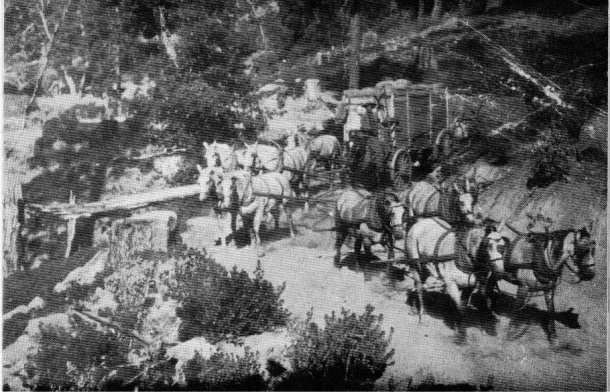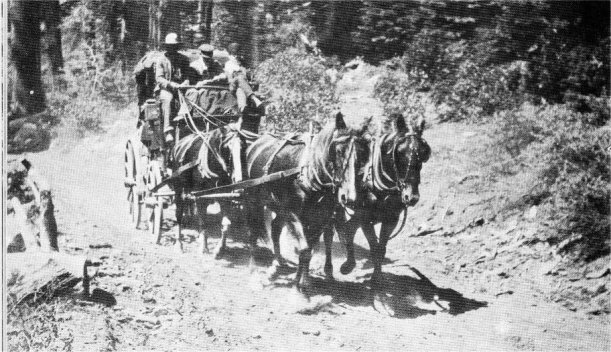
Wawona Supply Wagon
| Online Library: | Title | Author | California | Geology | History | Indians | Muir | Mountaineering | Nature | Management |
Yosemite > Library > Wawona’s Yesterdays > Roads and Trails >
Next: Stages & Drivers • Contents • Previous: Arboretum

Wawona Supply Wagon |
Soon after enthusiast James Hutchings began escorting sightseers to view Yosemite Valley in 1855, Andrew, Milton and Houston Mann built a 45-mile toll horse trail from Mariposa to the already-famous Valley via the South Fork. Mainly, they followed the old Indian trails. It was opened August 1, 1856, and operated as a toll route until 1862 when Mariposa County purchased it, declaring it a “Public Highway.” Until then, tolls were: [“]Man and horse each way, $2.00; pack mule or horse, each way, $2.00; Footman, $1.00.” 31
In 1869, Galen Clark organized a stock company of eight men to build a wagon and stage road from Mariposa as far as Clark’s 22 (Wawona) which was used as a toll road from 1870 until 1917. As early as 1870, Clark had a survey made for a wagon road from his lodging at Wawona to Yosemite Valley. This road was begun by Chinese laborers, under the direction of John Conway and Edwin Moore and finished by Washburn, Chapman & Company in July, 1875. 32 Most of the 16-foot-wide road was constructed during severe winter weather. The era of the stagecoach, which was to continue, in jolting, dusty fashion for forty years, began for Yosemite-bound visitors.
By mid-April, 1875, the rough road was passable for stagecoaches except for a narrow, 300-yard section still under construction near the old Inspiration Point. To the passengers’ temporary inconvenience and amusement, they walked the unfinished stretch while their quickly-dismantled stage was carried in pieces by hand, then reassembled, harnessed up, reboarded and driven off with considerable aplomb. 32
The Yosemite Stage & Turnpike Company (Washburn brothers), ran stages from Merced to Wawona via Mariposa where they had a livery stable.
The road from Raymond to Wawona generally followed the route of present State Highway 41, while the stage route from Mariposa, called the Chowchilla Mountain Road, exists today, rutty, dusty and little-changed from its 1870 route.
The Wawona Hotel was a logical and popular overnight stop for stage travelers, and the Yosemite Stage & Turnpike Company, operating two stage schedules and 700 horses, saw to it that their passengers traveled speedily and safely, though dustily.
In 1865, 369 hardy, saddle-sore travelers visited Yosemite. In 1875, mostly in stagecoaches, the Park had 2,423 visitors; 2,590 in 1885; 8,023 in 1902; and in 1914, when automobiles were allowed on the Wawona Road, 15,154. Travel doubled in 1915 when 31,546 visitors chugged in; 209,166 came in 1925 and 498,289 in 1932, 33 the last year of Washburn ownership.
The Wawona Road accounted for a number of Yosemite “firsts.” The first automobile to enter the Valley traveled it in 1900, and 32 miles of it had the honor of being the first paved road in the Yosemite region in June, 1902 34 Mud and dust were tamed!
Soon increased automobile traffic made oiled roads a necessity and, in 1932, the new, modern Wawona Road was completed from the South (Fresno) Entrance to Yosemite Valley.
After 1932, one South Entrance Station replaced the three stops maintained by the Turnpike Company. Tolls had been abolished in 1917, but traffic in and out of the Park from the Washburn domain had been checked until it became part of the Park.

Stage and Four Approaching Wawona |
Next: Stages & Drivers • Contents • Previous: Arboretum
| Online Library: | Title | Author | California | Geology | History | Indians | Muir | Mountaineering | Nature | Management |
http://www.yosemite.ca.us/library/wawonas_yesterdays/roads.html